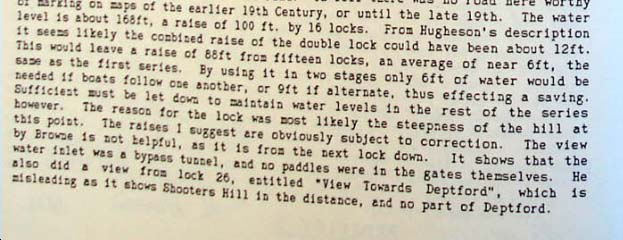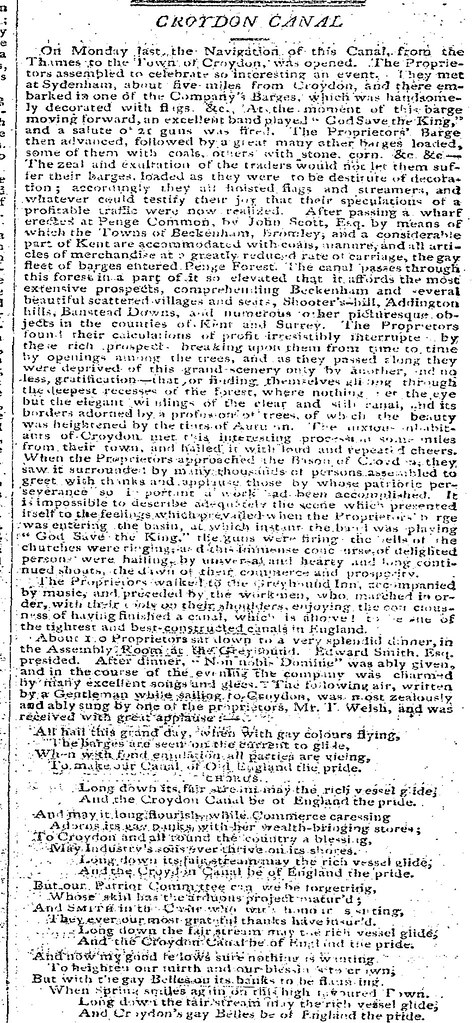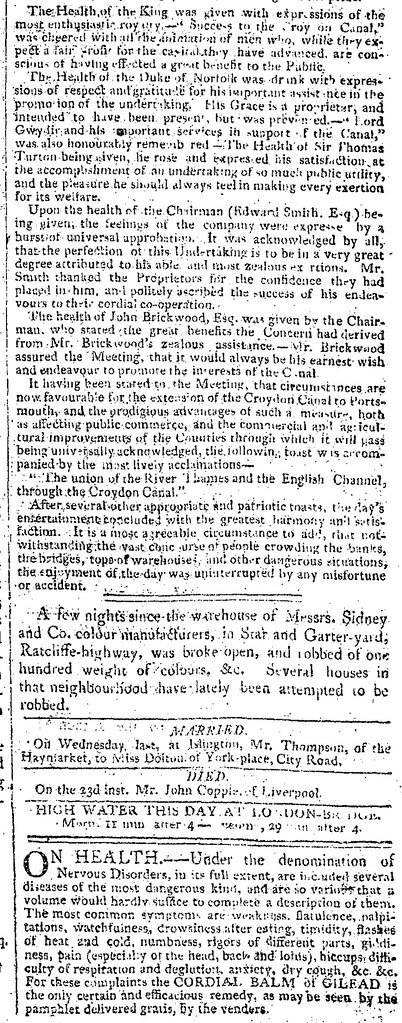Pictures of the Croydon Canal
-
will greenwood
- Posts: 352
- Joined: 14 Jan 2008 23:45
- Location: moorlinch
It's strange, isn't it? The map published in 1833 shows no such path or bridge where Dalrymple Road runs across the railway today, but on the estate map it does! And it's aligned in exactly the same position as the road today--based on the lining up of field boundaries and main roads to the east--in-between 2 ellipses of the canal. All this research is great, not only for the Croydon Canal, but also Brockley/Crofton Park history in general. That 1833 map scared me when I first saw it, but now I'm starting to figure out certain things even though it's not very accurate at all--atleast not as far as main roads are concerned.
-
will greenwood
- Posts: 352
- Joined: 14 Jan 2008 23:45
- Location: moorlinch
I see... so it could have been a more modern type of bridge? In that case, how can we figure out if other trackways passing over the canal were via a swingbridge or a footbridge? Even the "official" map indicates a crossing of some sort along the line of what is now Dalrymple Road; it's possible to count all the crossings using these maps. I did wonder when those maps were surveyed, and it now seems to be in the later years of the canal.
-
will greenwood
- Posts: 352
- Joined: 14 Jan 2008 23:45
- Location: moorlinch
thinking logically...
a lock would have a standard footbridge accross the lock, being narrow.
a swing bridge would be where the canal narrows like at Dartmouth Arms, where the road isnt too important,.
sometimes there would be a swing bridge before a lock, but not often.
I dont reckon there were 30 swing bridges over this canal...maybe 30 bridges
sydenham would have had a stone arch style xcrossing, but dead lane or similar would be crossed like the one in the painting...straight accross the top of the lock
a lock would have a standard footbridge accross the lock, being narrow.
a swing bridge would be where the canal narrows like at Dartmouth Arms, where the road isnt too important,.
sometimes there would be a swing bridge before a lock, but not often.
I dont reckon there were 30 swing bridges over this canal...maybe 30 bridges
sydenham would have had a stone arch style xcrossing, but dead lane or similar would be crossed like the one in the painting...straight accross the top of the lock
Okay, well thanks for alerting me to the fact that different types of bridges crossed the canal. I'm now going to get down to some proper research, including the re-reading of the main book and website, which I've been stalling over the last few days. I'm still not quite sure about the boat house you referred to and it's connection with Devonshire Road Nature reserve. Again, I'll be going over some of this stuff, and if anything else springs to mind I'll let you know.
-
will greenwood
- Posts: 352
- Joined: 14 Jan 2008 23:45
- Location: moorlinch


these are the sections about the boat house and the painting....it seems it was the view up from lock 25 after all.
Last edited by will greenwood on 10 Feb 2008 16:15, edited 1 time in total.
-
Stewart Marchant
- Posts: 3
- Joined: 28 Jan 2008 10:05
- Location: Rutland
Bridges on the Croydon Canal
Following on from my posting last week I have obtained a copy of "Retracing Canals to Croydon and Camberwell" published by Living History Publications in association with Environment Bromley.
On page 16 is the following quote
"Rees Cyclopaedia also says "There are seven road bridges and 30 accommodation swing bridges" "
The cyclopaedia was apparently published in 1819.
The paragraph continues "At least two roads that we now consider major crossed at swing bridges, a number of crossings were part of the lock construction."
The author identifies one swing bridge in Sydenham at the junction of what is now Stanstead Road with London Road and Perry Vale, and 2 in South Norwood - one in the Portland Road area and one in the Beckford Road area which served Selhurst Farm.
It is going to be very difficult to identify all the locations for certain, but based on my visits to other canals there are clues that can be looked for.
For example a bridge built over the 'downstream' end of the lockchamber is more likely to be fixed, since towed boats can pass easily underneath. A bridge across the centre or upper end of the lock chamber is more likely to be movable since the water level will be higher.
Given the balance of 7 road to 30 swing bridges quoted by Rees, it is probable that the major routes would have the more costly arched bridges, while farm accommodation bridges built only for the occasional use of the landowner to gain access to land cut off by the construction of the canal would be cheaper movable structures that did not need such major works to construct.
Hope I am not stating the obvious too much with all that!
I am fascinated by the old maps you are studying - where can they be seen?
On page 16 is the following quote
"Rees Cyclopaedia also says "There are seven road bridges and 30 accommodation swing bridges" "
The cyclopaedia was apparently published in 1819.
The paragraph continues "At least two roads that we now consider major crossed at swing bridges, a number of crossings were part of the lock construction."
The author identifies one swing bridge in Sydenham at the junction of what is now Stanstead Road with London Road and Perry Vale, and 2 in South Norwood - one in the Portland Road area and one in the Beckford Road area which served Selhurst Farm.
It is going to be very difficult to identify all the locations for certain, but based on my visits to other canals there are clues that can be looked for.
For example a bridge built over the 'downstream' end of the lockchamber is more likely to be fixed, since towed boats can pass easily underneath. A bridge across the centre or upper end of the lock chamber is more likely to be movable since the water level will be higher.
Given the balance of 7 road to 30 swing bridges quoted by Rees, it is probable that the major routes would have the more costly arched bridges, while farm accommodation bridges built only for the occasional use of the landowner to gain access to land cut off by the construction of the canal would be cheaper movable structures that did not need such major works to construct.
Hope I am not stating the obvious too much with all that!
I am fascinated by the old maps you are studying - where can they be seen?
-
Stewart Marchant
- Posts: 3
- Joined: 28 Jan 2008 10:05
- Location: Rutland
swing bridges
Hi Falkor
I've just taken a more detailed look at the maps that you provided a link for on your posting of the 28th. I reckon I can identify 17 crossing points from those maps - 5 of which appear to be roads and 12 are smaller bridges across lock chambers or farm accommodation bridges. That's a good start!
(Unfortunately I can't make out some of the road names.)
I've just taken a more detailed look at the maps that you provided a link for on your posting of the 28th. I reckon I can identify 17 crossing points from those maps - 5 of which appear to be roads and 12 are smaller bridges across lock chambers or farm accommodation bridges. That's a good start!
(Unfortunately I can't make out some of the road names.)
-
will greenwood
- Posts: 352
- Joined: 14 Jan 2008 23:45
- Location: moorlinch
I just mapped Those images onto google earth..
This is unlikely to be a lock keepers cottage...as it stood on top of Frog Hill on the Norwood loop, on Sunnybank rd..which is nearly 1 mile from the nearest lock ar Selhurst, where there was a lock keepers cottage near the swing brodge, as shown in one of the other images.
This is unlikely to be a lock keepers cottage...as it stood on top of Frog Hill on the Norwood loop, on Sunnybank rd..which is nearly 1 mile from the nearest lock ar Selhurst, where there was a lock keepers cottage near the swing brodge, as shown in one of the other images.
-
will greenwood
- Posts: 352
- Joined: 14 Jan 2008 23:45
- Location: moorlinch
I'm not sure if this has been posted before, but I know I've seen quotations from it...
from The Morning Chronicle (London, England), Friday, October 27, 1809; Issue 12625;


from The Morning Chronicle (London, England), Friday, October 27, 1809; Issue 12625;


Last edited by will greenwood on 10 Feb 2008 16:16, edited 2 times in total.
-
will greenwood
- Posts: 352
- Joined: 14 Jan 2008 23:45
- Location: moorlinch
....glad to be of service!
yes, indeed...perhaps it would be good to tie all this up in a book...after all, its only been a few weeks, and I reckon we've cleared up quite a lot...
(clouded a few over as well, eh.. )
...i got access to some interesting databases via the Open University..( I'm an on/ off student)...
i'll start having a good look round tomorrow...
those aerials are proving tricky.
yes, indeed...perhaps it would be good to tie all this up in a book...after all, its only been a few weeks, and I reckon we've cleared up quite a lot...
(clouded a few over as well, eh.. )
...i got access to some interesting databases via the Open University..( I'm an on/ off student)...
i'll start having a good look round tomorrow...
those aerials are proving tricky.



